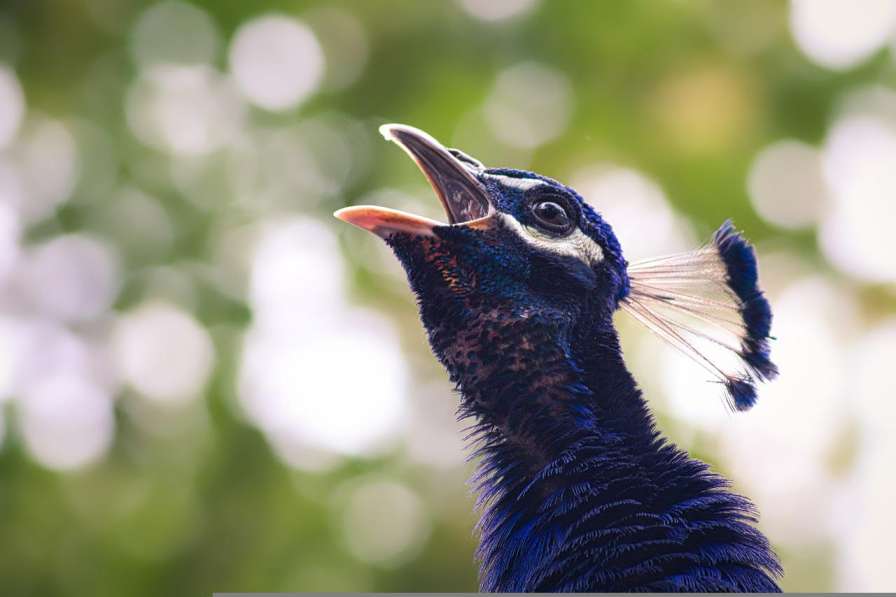Have ever wondered what sound a peacock makes? Read on till the end as I explain the peacock sound, its types, and other interesting information.
What Sound Does A Peacock Make?
A peacock makes a loud and nasal call “may-awe” mostly at dawn and dusk. However, they can also make other kinds of sound based on different activities like mating, communication, and responding to any disturbances.

In many regions of the peacock’s natural and introduced ranges, the may-awe is a popular sound.
Did you know? The typical loud calls “May-awe” given by the Male Indian Peacock can be heard up to 1km of area!
Peacocks make calls at different times of the day and at night. They can be very noisy at the roosting sites.
In the wild, the presence of a nearby predator is often betrayed by the may-awe call.
But there are other different call types of the peacock as well. Let’s explore!
Types of Peacock Sound
It is important to note that the Male birds are termed “Peacock”. Whereas, the female birds are referred to as “Peahens”. And collectively, we call them “Peafowls”.
A study was done regarding the vocalizations of Indian peafowl. Around 13,420 recordings were done and based on that, 7 different call types made by only the male birds and 6 alarm call types made by both genders were identified.
| Call: | Description: | Other Notes: |
| “Keow” | A loud, long, call with large frequency modulation. This call was made only by the adult males and specifically the territorial ones. | The adult males (mainly territorials) tend to jerk their neck and head mostly in the absence of females in the territory. This call also motivated the surrounding males to respond with the same call. Moreover, this call was also made by the males when they ran about their territory and when they used to dispute territorial boundaries with the neighbors. |
| “Ka” | This call was made only by the male (mostly territorial) adults specifically as they slowly opened their trains. | The Ka sound at times also followed the Keow sound in quick succession but it sounded more monotonous and urgent. Also, the single note of girk sound remained attached at the beginning. |
| “Hoot-Call” | This was a long, hoarse, but non-repeating vocalization. Only male adults make use of this call but in captivity, even the sub-adult males may use this call if they get a chance to mate with a female. | The hoot-call regularly goes along with male hoot-dash. |
| “Eow” | A loud, long, and repetitive sound. This specific call was only made by the males but interestingly there wasn’t any pre-requisite of maturity. Even a second year male made this call. | Generally, for Keow calls, intense neck pumping was required. But for this call, it was not necessary. |
| ‘‘Eon1’’ | Male of two years old made this call. | It was a short, repetitive call that had emphasis on the latter part of the note. |
| “Eon2” | Only males made this call and it was a rare call. | This call had an emphasis on the beginning of the note. Age limit of the birds making this sound is not known because it is a rare sound. |
| “A” | This was a short, single sound. | This call was made by males of at least two years old. |
| Alarm Calls (6 Types) | Alarm calls were made when there was any presence of predators like red foxes or stray dogs, and even by disturbances from other animals, including the humans. | Six kinds of alarm calls were identified that includes: “Bu”, “pe”, “bu-girk”, “pe-girk”, “Khok”, and “Kokok” |
The “Keow”, “Ka”, and “Hoot calls” were primarily made during the breeding season.
On the other hand, the “Eow” sound which happens to be the most common call in the male birds, was made mainly for ordinary vocal contact.
This call sounded throughout the year specifically at dawn when the birds roosted. Even the subadult males could produce the sound.
In short, the “Eow” sound was made when the males were not in the breeding situation.
Sidenote: The “Eow” sound observed in this study is comparable to the calls of “May-awe” or “Mee-ow”.
Another study was done on the behavior ecology of the Javan Green Peafowl. Through that study, around seven types of calls of the peafowl were observed as follows.
| Sound: | Description: | Other Notes: |
| “auwo” | Most common call of communication in the peafowl population | There are three variations of this auwo sound: auwo one time, auwo, two times, or auwo three times. |
| “kokoko………” | This type of call is usually made while the peafowl is flying. This sound is associated when there are disturbances. | The call lasts less than twenty seconds. And there are two variations of this call. Out of that, the first variation of the sound they make is when they get startled and want to inform others regarding any disturbance. |
| “Kroooooooow” | This sound is specifically made when the birds feel suspicious and find their chick or friend. | This call is repeated many times while the bird walks. |
| “Tek, Tek, Tek………” Tek, Tek, Tek…..Kroooooooow. or Tek, Tek, Tek…..Krooooow kokoko. | This sound is made when the bird suspects something and it is usually made by the female birds. | Aside from the tek,tek,tek…., sound, they can also combine the call as tek,tek,tek… . krooooooow or tek,tek,tek… . krooooooow kokoko. Out of that, the first variation (tek, tek, tek …..krooooow) indicates that a female peafowl is looking for her group or it can be a sign that demands other peafowls to notice something that is supposed to be suspected. |
| “eewooooo’ ‘eewwaooo” | Only the adult male bird makes this sound. | The call is made during the mating season. |
| “ngeeeeeeyooo” | Again, this call is only made by the adult male bird. | The sound is made during the mating season. |
| “Sheeiiks” | This sound is made only by the adult male birds. | The sound is made during copulation. |
Read Also: Can Peacocks Fly? How Far?
Why Do Peacocks Make Sound?
In general, animals make sounds as a response to external events. Most often, they tend to make sounds because of the reasons like:
- Discovering food
- Encountering a predator
- Interacting with conspecifics
We already saw a detailed overview of the different sound types made by peacocks. So In general, we can conclude the following reasons why a peacock makes sound:
- During the breeding season related to mating,
- When getting startled by any disturbance in the surroundings and informing others,
- Communicating with others, finding others in the group,
- When they dispute territorial boundaries especially made by territorial males,
Hearing the peacock sound only once a while can be okay. But if you live near a peacock-populated area and constantly hear those sounds and screams, it may become unpleasant.
Do Peacocks Make Noise?
Yes, peacocks can make noise with their typical high-pitched meow call. Generally, they make most of the noise in the early mornings and late evenings in the mating season and that can cause the neighbors to complain.
There are also several problems with peacocks, especially when they come in human-populated areas.

Firstly, they tend to wander and like to roost in trees. But the issue is they can also roost on the roofs where the damage can occur.
They also like to perch on cars and attack the reflection. As a result, damage can be expected due to pecking and scratching.
Furthermore, they often tend to dig up flower beds and harm the garden while foraging for food.
So If you spot a lonely peacock nearby (especially in areas where they are not usually supposed to be), it would be best to notify the concerned local wildlife authorities about the presence of the bird.
In most cases, the concerned authorities can do the needful to relocate the bird in a proper location that is safe for the bird as well.
Related Read: Do Peacocks Eat Snakes?
Final Thoughts
In short, the peacock is a wonderful and complex bird with different sound types indicating various behavioral aspects. Most commonly, they make the sound to mate but can also do while communicating or while informing others of any disturbance.
Peacocks generally make loud calls when it’s’ their mating season in full swing. However, outside of that mating season, they don’t usually make sounds unless they get startled.
When a peacock gets separated from the rest of the group it can make sounds to communicate and relocate the group. But that is usually different from the typical mating calls.
Whether you like the peacock sound or not, that’s up to you. But the next time you get the chance of watching this beautiful creature, take a moment to appreciate nature’s wonderful creation!
Hope you found this guide helpful. Please share this resource with other peacock fans. That’s it! Thanks, and see you again in my next blog post 🙂

